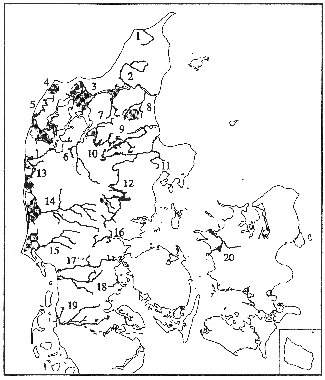 |
Last Update:
Thursday November 22, 2018
|
| [Home] |
BACKGROUND The European Otter (Lutra lutra) is one of the most endangered mammals in Denmark. In spite of a total protection of the species since 1967 a survey in 1986 showed that there were only few hundred animals left. Since then, the public authorities and protection agencies have intensified the efforts to save the Danish otter population. There are positive indications of a successful enhancement of living conditions for otters in Denmark. Recent surveys of the distribution of the otter indicates that the population has stabilised and in some core areas even increased in number. MANAGEMENT PLAN It is, however, necessary to continue the intensive work which has been initiated to support the otter population. Therefore, The Danish Ministry of Environment and Energy has developed an Otter Management Plan. The purpose of the plan is to gain the necessary knowledge and to establish comprehensive guidelines for the protection and consolidation of the Danish otter population and its habitats. Furthermore, the plan is an integral part of the strategy for maintaining the biological diversity in Denmark. SURVEYS AND RESEARCH The game bag statistics show that up to 1960, otters were bagged all over the country. Today the distribution of the otter is monitored by systematic field surveys. These show that the geographical occurrence is primarily limited to Mid- and Northwest Jutland. Veterinary investigations of dead otters show that health status of the population is generally good with a low contamination of toxic compounds. THREATS The most predominant causes of manintroduced mortality of the otter are drowning in eeltraps and traffic deaths. Consequently, barriers in eel traps are now required by country-wide regulations in fresh water areas and in certain salt water areas; in addition fauna passages have been established at a number of road systems. Disturbances from the intensified recreative use of the wetlands areas may be an additional factor to the distribution of the otter. AREAS OF INTEREST TO THE OTTER Pursuant to the EU-Habitat Directive on conservation of natural habitats and of wild fauna and flora, a coordinated European ecological network of Special Areas of Conservation shall be established for among other things the conservation of the European Otter. Based on the national proposals for Special Areas of Conservation, the plan points out so called Areas of Interest to the Otter ( Fig. 1 ). The areas of interest include all Special Areas of Conservation proposed. Furthermore, areas particularly relevanfor the establishment of a connected ecological network of habitats and corridors for migration of otters, are included.
ACTION PLANS The National Forest and Nature Agency propose that the counties in question work out specific action plans for each area of interest or includes an action plan as an integrated part of the total planning for the areas. An action plan may include, among other things, nature restoration and reserves for otters and a surveillance programme. Furthermore the Agency recommends meetings with the counties in order to exchange experience from the protection work. MONITORING The development of the otter population is followed by a national monitoring programme - on a five year interval - with a country-wide mapping of the distribution of otters. The national monitoring together with data gathered by the counties will show the effects of the protection efforts. REINTRODUCTION The National Forest and Nature Agency has worked out a programme for orphans and injured otters including nursing and reintroduction of the animals. Reintroduction will take place in border areas with a low population density so that the animals contribute to a natural recolonisation in the distribution area. REVISION OF THE MANAGEMENT PLAN It is proposed to review and revise the plan every five years. It will be appropriate to revise the plan in the year 2001, shortly after a new national otter survey. The management plan, 48 pages in all, is written in Danish with an English summary and English subtitles in figures and tables. For special interested conservationist copies of the plan can be requested by letters or fax (+45 75272514) from the first author. |
| [Copyright © 2006 - 2050 IUCN/SSC OSG] | [Home] | [Contact Us] |
